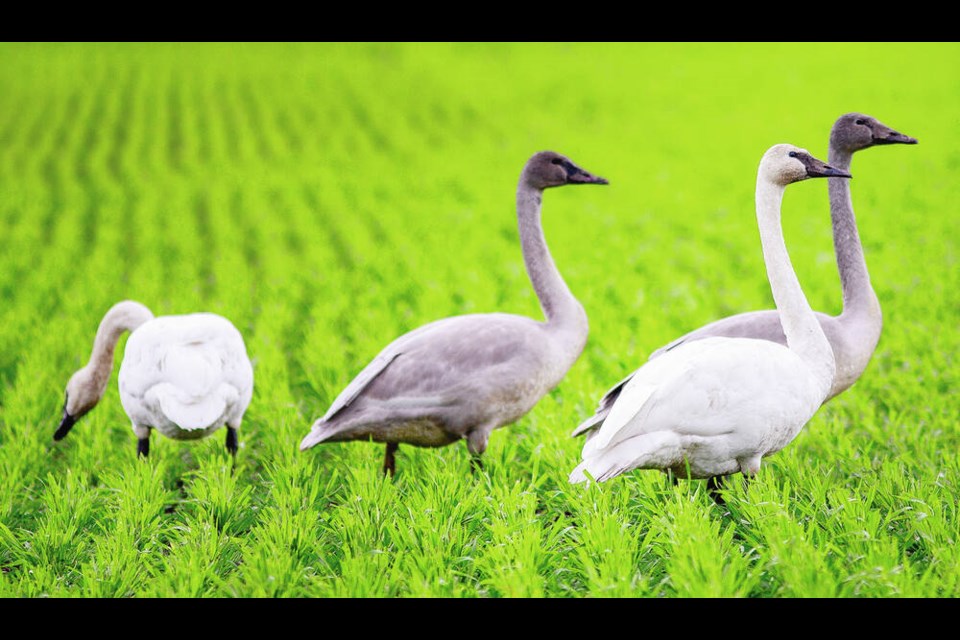Victoria’s Christmas Bird Count had so much more than seven swans a-swimming and six geese a-laying.
Field counters in North Saanich found a bright red summer tanager.
Birders in Ross Bay Cemetery were treated to the rare sight of pygmy nuthatches and white-breasted nuthatches.
And trumpeter swans on Central Saanich farmlands gave hope to bird enthusiasts that a species on the brink of extinction can come back and flourish.
“We had a great count, the highest participation we ever had, and that makes me very, very happy,” said co-ordinator Ann Nightingale.
More than 400 people were actively involved in the 2023 Christmas Bird Count. More than 300 birders were out in the field.
Another 70 — families and adult beginner birdwatchers — went on easy bird walks at the children’s Christmas bird count in Beckwith Park, Nightingale said. Between 40 and 50 feeder watchers submitted an online form, reporting the number of birds at their feeders.
“We counted more than 85,000 individuals of 143 species. We’re likely to be the top in Canada again,” she said.
The bird most people were excited about was the summer tanager, a bird with all-red plumage, the only completely red bird in North America.
“It has been in North Saanich for a few weeks but we didn’t know if it was actually going to show up on count day,” said Nightingale.
The bird was counted in the Sidney Christmas Bird Count, a long way from its typical winter range in warmer climes in Central and South America.
Trumpeter swans, seen in the fields around Michell’s Farm, are one of the really good news stories, said Nightingale.
“They were almost made extinct in the early 1900s,” she said.
“In fact, the Migratory Bird Convention Act was brought about because of the fear of losing more birds, like these swans, to extinction from overhunting. Now the population has come back and been a real success story in how if we are committed to turning this around, we can.”
The swans usually arrive in October and November, and stay until March or April.
Christmas bird counts are generally a good news story, but overall there has been a decline in the diversity and number of birds.
The highest number of birds counted in Victoria was 125,518 in 1993 when fewer people were out counting.
In Greater Victoria, teams of counters are assigned to one of 23 zones, with each team responsible for recording all the birds they see in their territory. The number of birds was up this year because some of the birders were able to get out on the water and count seabirds, said Nightingale.
She is concerned that about 15 species turned up in only one count zone.
“In future, they may not show up in any count zone,” she said.
Grouse, typically found on Skirt Mountain, have been pushed out by development. Sanderlings, which used to be seen in five or six different zones, are no longer seen. There are just a handful of skylarks.
“We haven’t had one on the Christmas Bird Count for years now,” said Nightingale.
Some species are no longer here.
Other species, such as the white-throated sparrows, are increasing in number. Turkey vultures are staying throughout the winter, and great horned owls are having a surge.
In 1993, 40 Anna’s hummingbirds were counted. This year, birders counted 1,396.
“Changes do occur in both directions,” Nightingale said.
On Jan. 24, the Victoria Natural History Society is hosting a Zoom talk for birders on what has been learned from 123 years of Christmas Bird Counts.
Nicole Michel, director of quantitative science with the National Audubon Society, will cover what the latest results tell us about how birds are responding to the threats they face, as well as the conservation actions taken to protect them.
For information see the Victoria Natural History Society website vicnhs.bc.ca.
>>> To comment on this article, write a letter to the editor: [email protected]



